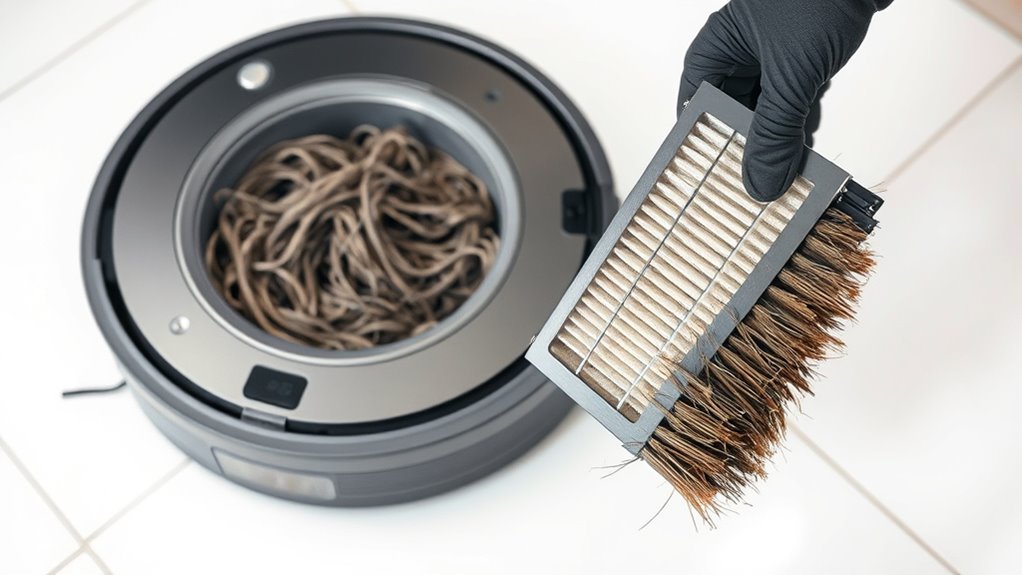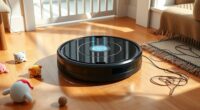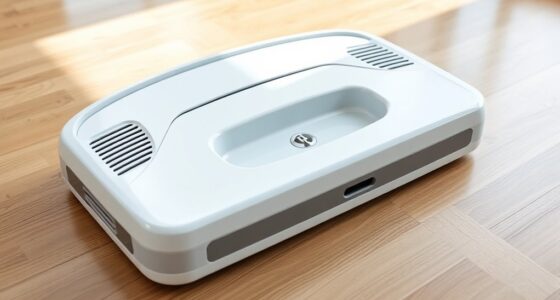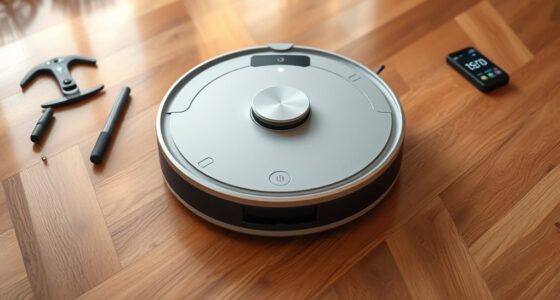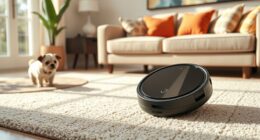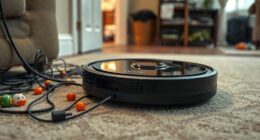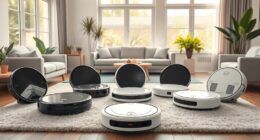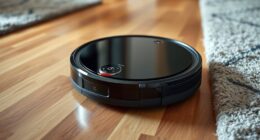You should replace your robot vacuum’s filters every 2 to 3 months for the best suction and air quality, and swap out brushes every 6 to 12 months or sooner if you notice frayed bristles or decreased cleaning performance. Signs like reduced suction, visible damage, or increased dust indicate it’s time for replacements. Factors like usage frequency and environment affect these timelines. Keep up with tips and guidelines for ideal maintenance—more details follow.
Key Takeaways
- Replace filters every 2–3 months for optimal suction and air quality.
- Change brushes every 6–12 months or when bristles are frayed or worn.
- Increase replacement frequency if you have pets or a dusty environment.
- Regularly inspect filters and brushes for damage or reduced performance.
- Follow manufacturer guidelines for specific replacement intervals and compatible parts.
Recommended Replacement Intervals for Filters and Brushes
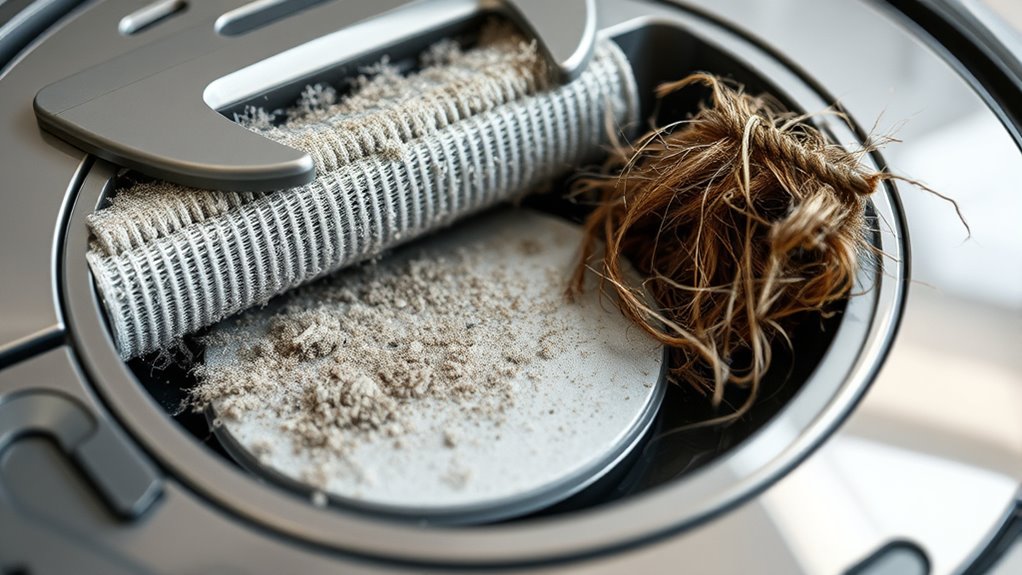
To keep your robot vacuum working efficiently, you should replace the filters and brushes regularly. The filter lifespan varies depending on usage but generally should be replaced every 2 to 3 months to maintain suction power and air quality. Brushes experience wear over time; most manufacturers recommend replacing them every 6 to 12 months. If you notice the brush bristles are frayed or worn down, it’s a sign it’s time for a replacement. Regularly changing filters and brushes ensures ideal cleaning performance and prolongs your vacuum’s lifespan. Keep an eye on the condition of these parts and follow the recommended intervals to avoid reduced efficiency. Proper maintenance ultimately keeps your robot running smoothly, saving you time and effort in the long run. Additionally, monitoring component wear can help prevent unexpected breakdowns.
Signs Indicating It’s Time for a Replacement

Even with regular maintenance, your robot vacuum’s filters and brushes may show signs they need replacing. If you notice reduced suction, it’s a clear sign your filter has reached the end of its filter lifespan. Excessive brush wear, such as bristles bent or missing, indicates it’s time for a new brush. Listen for unusual noises or vibrations, which suggest debris buildup or worn components. Check the table below for common signs:
| Indicator | What to Look For | Action Needed |
|---|---|---|
| Reduced suction | Dirt not picked up easily | Replace filter |
| Visible brush damage | Bent or missing bristles | Replace brush |
| Excessive dust release | Dust escaping during cleaning | Replace filter |
| Noisy operation | Unusual sounds | Inspect and replace |
| Decreased cleaning efficiency | Dirt missed or missed spots | Replace brush |
Regular maintenance can help prolong the lifespan of your vacuum parts, but eventually, excessive wear will require component replacements to maintain optimal performance.
Factors Influencing Replacement Frequency

Several factors determine how often you should replace your robot vacuum’s filters and brushes. First, the filter lifespan depends on how much debris and dust your vacuum encounters daily. The more it works, the faster the filter clogs, reducing suction power. Second, brush wear varies with usage; if you have pets or thick carpets, your brushes will wear out quicker, affecting cleaning efficiency. Third, environmental conditions play a role—dirtier homes or areas with more allergens cause filters to clog faster and brushes to degrade sooner. Staying attentive to these factors helps you gauge when replacements are needed, ensuring your vacuum maintains ideal performance and keeps your home spotless. Regular assessments based on these elements can save you time and money in the long run. Additionally, understanding fan culture and how support communities influence industry trends can offer insights into product development and user preferences.
Maintenance Tips to Extend the Lifespan of Your Components
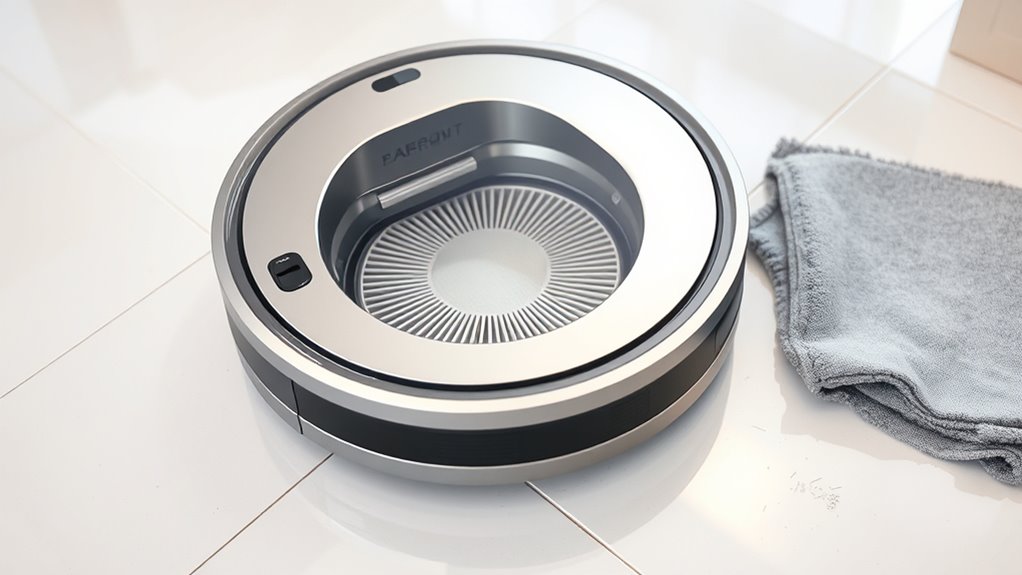
Regular maintenance is key to prolonging the life of your robot vacuum’s filters and brushes. Start by regularly performing filter cleaning to prevent buildup that can reduce suction and strain the motor. Remove the filter, tap off loose debris, and wash it if the manufacturer permits. For brush maintenance, check for tangled hair or fibers and remove them carefully with scissors or your fingers. Keep brushes free of debris to ensure ideal spinning and cleaning efficiency. Also, inspect the brushes for wear and tear, replacing them when they become frayed or worn down. Consistent upkeep not only improves cleaning performance but also minimizes strain on the motor, helping your vacuum components last longer and perform at their best. Incorporating routine inspections can further help identify issues early and maintain optimal operation.
When to Consult the Manufacturer’s Guidelines
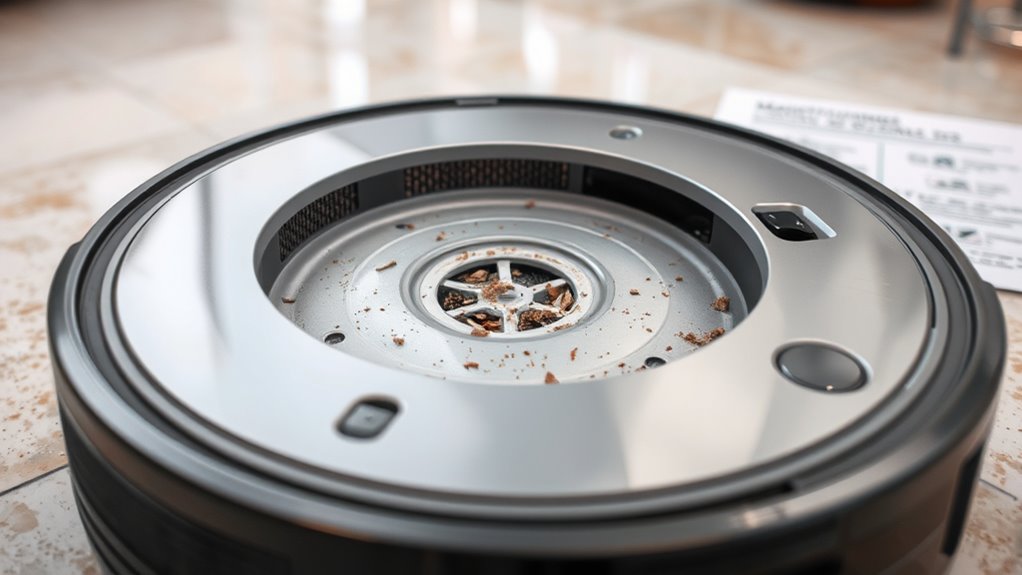
Knowing when to consult the manufacturer’s guidelines is essential for proper maintenance and avoiding damage. Your robot’s filter material and brush design vary by model, so following specific recommendations helps ensure peak performance. Here are three key moments to check the guidelines: 1. If you notice reduced suction or strange noises, it could signal worn filters or misaligned brushes. 2. When replacing parts, verify the recommended intervals to prevent premature wear or damage. 3. If you’re unsure about cleaning techniques or compatible replacement parts, always refer to manufacturer instructions. Regularly inspecting your robot’s components can also help identify performance issues early on. Consulting these guidelines helps you avoid unnecessary repairs and keeps your robot running smoothly. Remember, the proper care of filter material and brush design prolongs lifespan and maintains cleaning efficiency.
Frequently Asked Questions
Can Using Generic Filters Affect My Robot Vacuum’S Performance?
Using generic filters can impact your robot vacuum’s performance, especially if they aren’t compatible with your model. Poor filter compatibility may reduce suction and strain the motor, affecting brush durability over time. Cheaper or incompatible filters might not trap dust effectively, leading to clogs. To keep your vacuum running smoothly, stick with manufacturer-recommended filters and regularly check brush condition, ensuring ideal performance without risking damage.
Are There Eco-Friendly Options for Replacement Filters and Brushes?
You’re probably wondering if eco-friendly options like biodegradable filters and reusable brushes exist. The good news is, they do! Biodegradable filters break down naturally, reducing waste, while reusable brushes can be cleaned and used again, cutting down on replacements. Choosing these options helps protect the environment and saves you money in the long run. Look for brands that prioritize sustainable materials to keep your cleaning eco-friendly.
How Do Different Flooring Types Impact Replacement Frequency?
Think of your floors as a stage—each type demands different care. For hardwood or tile, regular flooring maintenance keeps dust at bay, so filters and brushes last longer. In contrast, carpets with dense fibers trap more debris, making frequent replacements necessary. You should monitor how your robot vacuum performs and inspect brushes often, especially with carpet fibers, to know when it’s time for a change. This keeps your floors clean and your device running smoothly.
Do Robot Vacuum Models Vary in Recommended Replacement Intervals?
You’ll find that robot vacuum models do vary in recommended replacement intervals. Some models have longer filter lifespans, while others see quicker brush wear. It’s important to check your specific model’s guidelines, as regular maintenance helps maintain ideal cleaning. Generally, replace filters every 1-3 months and inspect brushes regularly for wear. Staying on top of these intervals ensures your vacuum performs well and lasts longer.
Is There a Way to Tell if My Vacuum’S Suction Is Decreasing?
To tell if your vacuum’s suction is decreasing, pay attention to filter maintenance and observe suction indicators. If your robot struggles to pick up debris, loses power mid-clean, or takes longer to complete a job, these signs point to reduced suction. Regularly check filters for dirt buildup, clean them as needed, and monitor any changes in performance. Proper filter maintenance keeps suction strong and ensures your robot works efficiently.
Conclusion
Regularly replacing your robot vacuum filters and brushes keeps your device running smoothly, saving you time and money. Did you know that neglecting these parts can reduce cleaning efficiency by up to 50%? By paying attention to signs like decreased suction or strange noises, and following recommended intervals, you guarantee peak performance. Stay proactive with maintenance, and your robot will serve you well for years to come. Keep an eye on those components and enjoy cleaner floors effortlessly.
